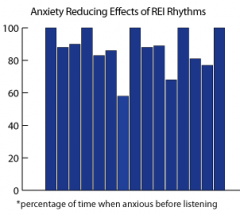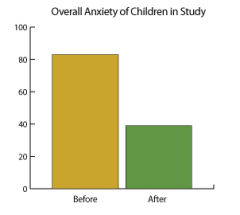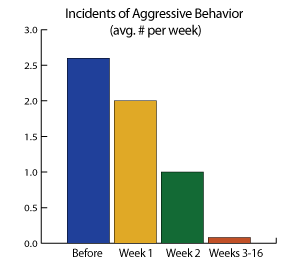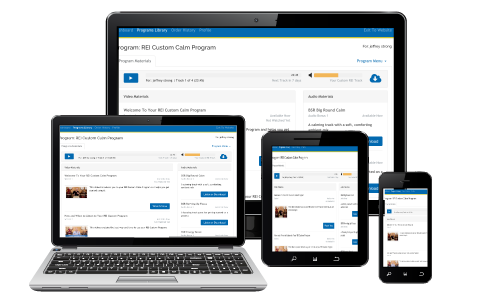Strong Institute
Creators of Rhythmic Entrainment Intervention™
REI Custom Calm Program
Complete Program to Reduce Anxiety
Sign Up Today
Choose Your Payment Option Below
Is Anxiety Ruling Your Life?
We all experience stress. We may have an unusually difficult day or worry about a particular event. We feel anxious, yet we bounce back.
Many of us, however, carry anxiety with us everyday. Sometimes it's subtle but other times it is disruptive or even debilitating. Every time it's something we want to gain more control of. If you or your child experience any of following, the REI Custom Calm Program is made for you.
Anxiety Could Be Impacting Your Life if:
• You Worry All the Time.
• You Feel an Underlying Sense of Unease or Dread.
• You Avoid Certain Social Situations.
• You Have Panic Attacks.
• You Get Angry or Frustrated.
• You Feel Paralyzed by Fear or Uncertainty.
Anxiety Could be Impacting Your Child's Life if:
• Your Child Throws Tantrums.
• Your Child Becomes Unresponsive or Retreats into a Shell.
• Your Child Worries Excessively.
• Your Child Won't Let You Out of His Sight.
• Your Child Avoids or Wants to Avoid Certain Places or Situations.
Anxiety is Your Brain's Response to Danger and the Unknown
Anxiety is a primitive brain response to both uncertainty and danger. It is biological. It is our first instinct. And long ago, it was essential for our survival.
Our ancestors faced real threats everyday. Our brains developed to help us perceive these threats and respond appropriately. After all, our very survival was dependent on it.
Nowadays, many of us have a heightened fight or flight response. We respond to even minor threats or uncertainties as though we are in mortal danger. This suspends our ability to respond rationally. Instead, our primitive brain overrides our intellectual thought, flooding our bodies with chemicals (Adrenaline) to help us act and avoid, or remove, the threat. This is the fight or flight response.
Rarely are the things we get anxious over truly a threat to our survival; the chemicals our primitive brain releases into our bodies make us feel anxious. Anxiety is a physical response to our perception of danger.
Lower Your Anxiety by Changing Your Brain
Most anxiety reduction techniques offer stopgap strategies to help you cope until the adrenalin is metabolized and your physical state returns to normal. The problem with this approach is that you are stuck in panic mode until the adrenalin is out of your system. This takes time.
Some anxiety-reducing techniques teach you to prevent a fight or flight response. The problem with these techniques is that they require you to think when your brain wants to act. This takes a lot of work.
There is a better way. Your your brain can learn how to release the chronic anxiety and respond to acute situations from a calm, resourceful place. The REI Custom Calm Program will teach your brain how to be calm.
Your REI Custom Calm Program Is Created Just For You
Whether you experience anxiety based-behaviors, tantrums, loss of sleep, panic attacks, social anxiety, or loss of concentration, we will create the optimal program to help you accomplish your goals.
We've Focused on Calm for Over 20 Years
Since our first clinical study in 1994, we have focused on how to reduce anxiety and induce calm. For ten years our research examined children and adults on the autism spectrum. This population proved to be an excellent anxiety-based arena for two reasons:
1. People with autism often have a lot of anxiety. And anxiety can rule much of their behavior. A child may tantrum when asked to enter a noisy, stimulating environment like a restaurant or shopping mall (or school lunchroom) or an adult may react aggressively when sharing mealtime with others.
Observing anxiety in people with autism is easy and noticing changes, however small, becomes simple. The cessation of crying in a tantrumming child or halting of aggressive behavior in an over-stimulated adult is an obvious measure of a reduction in anxiety.
2. Because autism is characterized by an inability to socially engage in an appropriate manner or an inability to communicate wants or needs, many people with autism have little to no awareness that some music (or other intervention) is going to be calming. And if they have such awareness, many have no idea how to self-regulate to calm on command.
This effectively removes the placebo effect. And because we are not using self-observed changes in anxiety, but instead use behavioral measures, we further remove any effects of the participants' expectation from the studies. Either a tantrum stopped or it didn't.
Our First Study Showed Significant Anxiety Reduction
Our first study was conducted in a public school setting with children between 6 and 12 years old. In this study we tracked immediate anxiety reducing effects as well as long-term changes in anxiety levels. In other words, we wanted to see if listening to REI Rhythms would reduce anxiety as it happened (ending a tantrum, for example) and whether any residual calming effect would result in changes of overall behavior.
Immediate calming effects were significant. Nearly all the participants were calmed most of the time.
The average frequency of time calmed by the recordings was 86.4%.
As far as overall changes in anxiety levels, we also saw significant changes as an average based on the pre and post tests. In the pre-test, average anxiety was listed at 82 on a 100 point scale. Anxiety on average after the study was reduced to 38 on a 100 point scale. This represents a significant reduction in anxiety over this 8-week period when the REI Rhythms were played quietly in the background.
Subsequent Studies Support These Results
Follow-up studies with autism as well as other conditions such as Anxiety Disorders, Attention Deficit Disorders, and Sleep Disorders, showed similar reductions in anxiety while listening to REI music.
For example, a study conducted in a residential facility for adults with severe autism showed significant changes in anxiety levels both facility-wide and in indivdual behavior.
One resident was extremely aggressive before the study began, often injuring other residents or the staff. Before the study, incidents were reported several times per week. Within two weeks of beginning using the REI recording, his aggressive outbursts virtually stopped. And they remained rare for the entire study period and extended follow-up of 6 months.
In another recent study, children within a public school showed significant reduction in anxiety-based behaviors while listening to REI rhythms. This study followed 10 students and showed reductions in behaviors in the following areas:
• Generalized anxiety
• Emotional outbursts
• Aggressive behaviors
• Self-stimulatory behaviors
• Sound sensitivity
As the study states: Anxiety reduction can take many forms, especially with the large variation of symptomatic behaviors and characteristics present in children on the autism spectrum.
Our Programs All Start with Calm
Our core program is a comprehensive home-based therapy consisting of:
• 12 Custom-created REI Audio Tracks. These twelve custom REI audio tracks employ progressive stimulation techniques made just for you and your responses to the music. Just as no two people are the same, you require unique stimulus to achieve the best results.
• Unlimited client support to make sure that you are indeed getting the best stimulation for your needs. We work closely with you to make certain you see significant improvements.
• 7 Brain Shift Radio audio downloads that can be used anytime you want additional benefits. These tracks include: Noisy Room Sleep, Revving-up Focus, Energy Boost, PowerNap Mix, Memory Boost, Big Round Calm, and Mood Lifter.
• Jeff Strong's Different Drummer book download to give you an understanding of how REI developed and how to best implement your program.
The REI Custom Calm Program Tackles Anxiety with a Two-fold Approach
Immediate Calm
Our first goal is to create an immediate sense of calm. We begin by injecting novelty to break the habitual anxiety response, followed by entraining the brain to a relaxed neurological state.
This stops a panic attack, a tantrum, an emotional outburst, or any of the fight or flight responses.
The more often you use the REI to stop a anxiety attack, the more easily – and quickly –your brain shifts to a calm state.
Long-term Change in Anxiety
Secondly, we teach your brain how to achieve a relaxed state on its own. We do this by providing progressive stimulation. Each of the tracks in our programs build on the previous track and teaches your brain how to respond from a more resourceful space.
This means that you will no longer feel that sense of dread. Your brain will respond to the world from a relaxed state. and no longer automatically enter a primitive, adrenaline-infused, brain response.
REI Custom Calm Program
The REI Custom Calm Program is a home-based auditory brain stimulation program that uses musical rhythm to stimulate and re-pattern neurological function. A unique blend of modern advances in brain research and ancient rhythmic techniques, REI facilitates long-term improvement in anxiety.
Custom created for you based on your unique form of anxiety: this is the key to our program. Whether you experience panic attacks or your child displays tantrums, or you feel a constant underlying sense of dread or your child constantly worries, we deliver the proper stimulus to achieve your goal of lower anxiety and a more functional life.
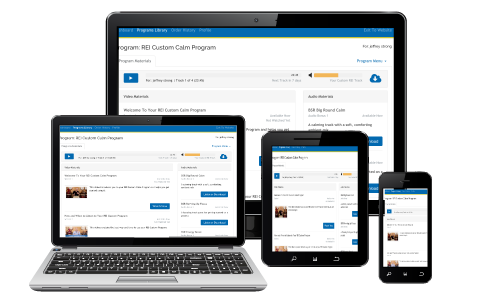
Once you begin, the REI Custom Program's interactive online platform and tracking ensures that you are always getting the stimulation that you need based on your real-world performance. Each new track of your program is dynamically engineered in response to your weekly progress.
The REI Custom Calm Program is a Complete Solution
This comprehensive anxiety-busting program consists of:
• 6 Custom-created REI Audio Tracks. These custom tracks employ progressive stimulation techniques made just for you and your responses to the music. Just as no two people are the same, you require unique stimulus to achieve the best results.
• Unlimited client support to make sure that you are indeed getting the best stimulation for your needs. We work closely with you to make certain you see significant improvements.
• 4 Weekly Mindful Meditation videos to help you gain awareness of your anxiety and offer support in changing your thought patterns. The Child program meditations can be used by the entire family to help you support your child and guide him toward a stronger awareness of anxiety triggers and how to manage them.
• 7 Brain Shift Radio audio downloads that can be used anytime you want additional benefits. These tracks include: Noisy Room Sleep, Revving-up Focus, Energy Boost, PowerNap Mix, Memory Boost, Big Round Calm, and Mood Lifter.
• Jeff Strong's Different Drummer book download to give you an understanding of how REI developed and how to best implement your program.
The REI Custom Calm Program requires no training or special equipment. Simply:
Play Your REI Custom Calm track once a day.
You can stream or download from your phone, tablet or computer. Tracks average between 22 and 26 minutes.
Play the track quietly in the background.
There is no need to actively listen to the music or to use headphones.
Check in with us at the recommended intervals.
You will receive an email every seven days asking you to complete your track adjustment feedback.
Get Started Today
Order now and receive instant access to your REI Client Center where you can answer the custom program intake questionnaire (takes just a few minutes). We will review your intake and deliver your first track to your account in a couple of hours. In the meantime you can download your bonus audio and Jeff Strong's Different Drummer book.
Sign Up Now
Choose Your Payment Option Below
Not Sure If this Program is Right For You?
Call 800-659-6644 or email [email protected]

100% Satisfaction Guarantee

Secure Payment
About the Program Creator
Jeff Strong is the creator of Rhythmic Entrainment Intervention™ (REI) and the Director and CEO of the Strong Institute, a research center and provider of evidence-based custom auditory brain stimulation programs. He is also the co-founder of Brain Shift Radio, a streaming music site containing personalized music to enhance brain function.
Jeff is a percussionist, composer, recording engineer, researcher, clinician, and a sought-after expert on the therapeutic use of rhythm. He is the best-selling author of eight books, including AD/HD For Dummies and Different Drummer: One Man’s Music and Its Impact on ADD, Anxiety, and Autism.
What Professionals Are Saying About the REI Custom Program
“I've had the BEST therapeutic effect with REI...”
"I have been trained in many 'listening' and music programs - and, to date, I have had the BEST therapeutic effect with REI. It is, by far, easier to implement than any other program, and from my perspective it has the most benefit and positive therapeutic changes!"
Theresa Garrison, OTR - Occupational Therapist
“My clients have experienced incredible gains...”
“The work that the REI Institute has done over the last 10 years is remarkable! My patients have experienced some incredible gains using the program. I am excited to have the opportunity to offer this program to the clients in my clinic.”
Jennifer Griffith, OTR - Occupational Therapist
“I loved all the information...”
"Let me say how much I enjoyed the training program! I loved all of the information and the format you used to present it. I have been through other 'sound' training programs and this was by far the best. I am excited to begin using REI."
Deb Wellmes, SLP - Speech-Language Pathologist
“I've seen improvements in all my clients...”
“I became a provider because there is research behind it. And many other programs that claim to be similar don’t have research behind them... I’ve seen improvements in all my clients."
Barbara Taylor, M.S., CCC-SLP - Speech-Language Pathologist
“...There have been positive changes with every patient who has used REI.”
“My experience REI has been overwhelmingly positive. It’s not a silver bullet...but there have been positive changes with every patient who have used it.”
Lisa Matthews, OTR - Occupational Therapist
What Clients Are Saying About Rhythmic Entrainment Intervention (REI)
“She is much calmer after REI...”
“Our daughter has had very few temper tantrums. She is also developing the ability to stop herself and calm herself down, usually within about one minute of when the recording starts.
She’s been getting along much better with her brothers and sisters. Her attention span has increased--she can sit quietly and read a book for longer periods of time. She’s paying attention more in school and staying on task.”
Lisa D. - Mother with 8 year-old with ADD
“We turned on the music and he responded instantly...”
“When we had the CD made, we put it in while he was in a session with his craniosacral therapist. He responded instantly! His system was calming down, and to the surprise of his therapist, he started vocalizing. …
We went from nothing to something with vocalizing… He is now starting to put sentences together, and I’m very pleased.”
Leslie J. - Mother with 19 year-old with autism
“I'm less anxious, more awake, more centered...”
Kristen K. - 28 year-old with anxiety and sleep issues
“He is less tactically sensitive...”
“We would definitely recommend the REI Custom Program™ to other parents with children on the Autism Spectrum. We tried other therapies including the Gluten/Casein Free Diet and the Tomatis Listening Program with mixed results. We have definitely seen improvements with our son while on the REI Custom Program.”
David S. - Father of a 9 year-old with autism
Get Started Today
Order now and receive instant access to your REI Client Center where you can answer the custom program intake questionnaire (takes just a few minutes). We will review your intake and deliver your first track to your account in a couple of hours. In the meantime you can download your bonus audio and Jeff Strong's Different Drummer book.
Sign Up Now
Choose Your Payment Option Below
Not Sure If this Program is Right For You?
Call 800-659-6644 or email [email protected]

100% Satisfaction Guarantee

Secure Payment
More About Rhythmic Entrainment Intervention
Following are a series of articles and videos exploring Rhythmic Entrainment Intervention.
Don't just take our word for it. Here are some real-life examples of anxiety reduction with REI.
Giselle Sees Big Changes in Social Anxiety and Fatigue
When Giselle began REI she was experiencing severe fatigue in the afternoons, which required her to go home from work at lunch to take nap in order to have the energy necessary to finish her day. As well, she described having feelings of anxiety for which she was seeing a therapist. She chose to try to REI Custom Program after using Calming Rhythms for her nap and noticing that she had more energy after listening to it.
After 1 1/2 weeks of using her REI Custom Program recording #1, she described that she had much more energy and didn’t feel the need to go home at lunch to take a nap. Instead she played her CD while she ate lunch. As well, so found that she spontaneously left her apartment one evening to go on a walk. Prior to this occasion she would need to get in her car from the basement garage and drive a few blocks in order to take a walk due to her anxiety over leaving the front door of her apartment building. She had been working on this issue in therapy for several years with no improvement until beginning the REI recordings.
After 8 weeks on REI, Giselle has much more energy and didn’t experience the afternoon fatigue that she had in the past. She also fond herself no longer having anxiety about leaving her apartment building on foot and took her daily walk without needing to drive her car from her building. She was continuing to listen daily to recording #2 during her lunch break.
Michael's Motor and Vocal Tics Stopped and His Anxiety Decreased
At the beginning of his REI Custom Program, Michael’s tics were present most of time, usually starting just an hour or so after waking in the morning and continuing until bedtime. His vocal tics included grunting and throat-clearing while his motor tics consisted of lip-smacking and picking, neck-rubbing, and finger-bending.
The degree and intensity of his tics seemed to be related to his anxiety and energy level. If he was tired, he exhibited more tics. Likewise, when he was anxious, his tics were more pronounced.
Michael also exhibited high levels of other anxieties. These centered around fear of new places, unexpected events, and separation from his parents. On a good day he was able to go to school without clinging and displayed only minor trepidation toward new or unexpected situations, such as an unscheduled trip to the store or an event outside his normal routine. His anxiety exhibited itself as clinginess, crying, and tic behavior, most notably vocal tics.
Early in his REI Program, Michael exhibited less anxiety over everyday changes, such as going to school or therapy sessions, where he is separated from his mom. His sleep also improved. His vocal tics were slightly less frequent, while his motor tics remained pretty much the same.
Midway into the program his parents noted that his motor tics remained somewhat variable, but their frequency overall was down from the beginning of the program. Stressful situations, as expected, increased his tic activity. Because his anxiety overall was lower than when he began the program, he seemed to be less bothered by situations that used to be stressful for him.
The vocal tics were essentially absent and there were longer periods of time with few, if any, motor tics. At one point during this period he caught a cold and his tics increased. They reduced again once his cold was over. This demonstrated more overall improvements but also suggested that stress on his system, both physically and psychologically, still had an impact on his tic behavior.
By the end of the REI program, Michael made significant gains in his sleep, anxiety, and tic behavior, with minor changes in some of his ADHD-type symptoms.
Read the entire case study here
Kathleen Learned to Manage Anxious Thoughts and Began Sleeping Better
Before beginning the program Kathleen's sleep was poor. She would often fall sleep within an hour of going to bed but she generally woke several times a night and had trouble getting back to sleep because she worried about things. She also experienced anxious thoughts throughout the day. The worst times were when she drove in her car. This anxiety often resulted in her getting disoriented and feeling lost even when on familiar roads. She also wouldn’t travel on a plane. In addition Kathleen was disorganized and often missed appointments.
After about 3 weeks using the REI Custom Program, Kathleen began sleeping through the night. In the rare occasions where she did wake up at night, she found that she could turn REI recording #1 on and her anxious thoughts would quickly dissipate.
At the 8-week point of listening, she was consistently sleeping through the night with only the occasional night where she woke up. Again, turning on REI recording #1 would help her get back to sleep within 20 minutes (the length of the REI recording). She found that she was more energetic during the day and was more organized. She also began implementing an organizational system to help to keep on top of things. As a result she hadn’t missed any appointments in six weeks. Her anxiety during the day had reduced significantly - she was able to drive to and from work without getting anxious, though she still didn’t feel comfortable driving anywhere new.
After 16 weeks, Kathleen was still sleeping well - only woke occasionally at night but would be able to get back to sleep quickly by playing her REI recording. She continued to improve in her ability to manage her anxious thoughts. She took a plane to a conference for the first time.
After 5 years, she reported that her sleep was still good and her overall anxiety level was still very low even though she hadn’t heard her REI recording in three years.
Jeff Strong Talks About Stopping Anxiety Attacks or Aggressive Behavior
This video Jeff Strong demonstrates how complex drumming can be used to stop an anxiety attack or aggressive behavior.
A Look at Rhythmic Entrainment Intervention by Its Creator
This article, written by REI Creator Jeff Strong, was published in: Insights into Sensory Issues for Professionals: Answers to Sensory Challenges, edited by Kathleen Morris. MS CCC/SLP. 2010.(Originally published in SI Focus Magazine, Fall 2008)
Auditory rhythm has a long history of use for affecting neurological function, with the earliest uses being documented tens of thousands of years ago. These original techniques are some of the most pervasive therapeutic practices known to man, existing on every continent even among people who had no contact with one another (Harner, 1990). As an ethnomusicologist I was fascinated by the commonality in the techniques within such disparate cultures. I spent over a decade trying to understand how the same basic therapeutic approaches developed when so many other aspects of these societies were vastly different.
The answer, it appeared, was that the physiological mechanisms at work are so powerful that experimentation by each culture resulted in a common finding: You can affect consciousness, cognition, and behavior by employing only two specific rhythmic techniques. One consists of a repetitive pulse while the other employs complex rhythmic structures.
Discovering such commonality among traditional therapeutic rhythm practices prompted another, perhaps more important, question: Can these therapeutic effects sustain themselves outside of the cultural context in which they developed? I believed so, but many of my colleagues did not, believing instead that the rhythm was secondary to the rituals they were imbedded in (and is often attributed to the placebo effect). This led to an odyssey that began in 1992 and has continued to this day, culminating in the development of Rhythmic Entrainment Intervention™ (REI).
REI is a music-medicine therapy (Spintge & Droh, 1992) that stimulates and synchronizes the listener’s brain. REI is available as some generalized CDs This is a custom-made, program that optimizes neurological function.
Auditory Rhythm to Stimulate the Brain
REI is unique in several ways. First, REI employs auditory rhythm to directly stimulate the listener’s brain. Other auditory programs use modulated frequency (Tomatis, 1992), binaural beats (Oster, 1973), or simply classical-based music (Rauscher, Shaw, and Key, 1993).
Auditory Driving
As I developed REI, my first step was to identify the core mechanisms of the traditional techniques. It turns out that these mechanisms are simple, powerful, and easily understood. First, human consciousness can be directly affected by an auditory stimulus. This is called “auditory driving” (Goldman, 1992). Auditory driving states that a listener’s brain wave activity will synchronize with the pulsation of an auditory rhythm (provided certain conditions are met).
Traditional practitioners would employ a four-beat-per-second rhythm, which would in turn facilitate a corresponding four-beat-per-second pulsation in the listener’s brain, resulting in bilateral neurological synchronization and a shift in consciousness to a theta state (this is a meditative state)(Maxfield, 1994). With REI we double the tempo to synchronize a listener’s brain into a relaxed neurological state called alpha. This is the state of consciousness where sensory processing is optimized.
Complex Rhythms
The second core mechanism involved in traditional therapeutic rhythm techniques consists of using complex rhythms to activate the brain (Scartelli, 1987; Shatin, Koner, Douglas-Longmore, 1961; Parsons, 1996). Here complex auditory rhythms stimulate the Reticular Activating System (RAS), a part of the brain that controls sensory input (Scartelli, 1992). Applying rhythm - especially complex rhythm – to activate the brain is one level of the stimulation provided by REI. As we conducted research we discovered another dimension to the rhythms: One that appears to be more important than just complexity. It seems that each rhythm produces a different response.
Once the core mechanisms were discovered the next step was to determine the best way to deliver the correct stimulus to aid in the areas in which I was interested. Traditional practitioners performed the rhythms live for each person and adjusted their rhythms based upon the responses they saw in their patient.
Daily Listening for Long-Term Change
This is where I started -- the first 1,000 people that REI was used for experienced this one-on-one, live stimulus. They also listened to a recording of one of their live sessions daily in their home. Daily listening was a departure from the traditions, but I felt that people needed the stimulation repeated consistently for a length of time in order for any long-term change to be expected.
One of the first children that I worked with in this manner was a seven-year-old girl on the autism spectrum. In this case, the girl, let’s call her Stephanie, was referred to me because of extreme anxiety. This anxiety impacted every aspect of her life: She wasn’t able to sleep in her own room and needed to be in constant contact with her mother; transitions and even minor changes in her environment were a point of crisis for her throughout the day.
She also had significant language and social delays. Her language consisted largely of repeating rote words and phrases. Although she had a large vocabulary, she was unable to communicate beyond her basic needs and desires. Socially, she lacked eye contact and wasn’t able to interact appropriately with her peers.
She calmed down within minutes during the first live session, and after the second session she remained calm and was able to sleep in her own room from that night on. Stephanie listened to a recording of her third live session everyday for eight weeks. At seven weeks she spontaneously described events in proper sequence for the first time. She was also developing social connections and had begun making friends.
She was mainstreamed at school (she was in a classroom with non-autistic children and had a one-on-one aide) and at 10 weeks the school psychologist evaluated Stephanie in her classroom and noted that she was “indistinguishable from the “normal” children in the class.” She continued listening to her recording for several more months and eventually no longer required her one-on-one aide.
Universal Calming Effects
This, and many other cases studies, led to a formal study conducted in a public school setting (Strong, 12). This study consisted of 16 children from age 6 to 12 who were on the autism spectrum. The results of this study showed almost universal calming effects (only one child was not calm most of the time, and this child ended up not being on the autism spectrum).
Long-term change was significant for anyone who heard the recording at least four times per week. This study caught the attention of several prominent autism professionals and led to a paper of this study being presented at several professional research conferences (including one organized by The Center for the Study of Autism led by Dr. Stephen Edelson, who went on to design all of our double-blind, placebo-controlled studies).
At this point my interest in exploring the therapeutic application of auditory rhythmic stimulation techniques deepened. I formed the REI Institute with Beth Kaplan with no intention of creating a “therapy” that would be available outside of a research environment. Our goal was simply to try to understand how auditory rhythmic could be used to enhance neurological function.
Over the next 10 years the REI Institute conducted numerous studies and presented dozens of scientific papers on what we were learning. Two of the key discoveries of this period were that synchronization was universal when certain techniques were applied and that each rhythm used elicited a definite, observable response over time.
Specific Rhythms’ Observable Effects
In other words, we found that we could introduce specific rhythms to have a pre-determined effect on each listener. To date, we have documented over 600 rhythms that seem to correspond to symptoms and combinations of symptoms. As a result we found it was critical to use just the right rhythms for each person in order to have the greatest positive benefits for that person.
During the 1990s, the REI Institute conducted a series of double-blind, placebo-controlled studies to try to understand the best approaches to take in balancing auditory stimulation and synchronization. What we learned in a nutshell was that the custom-made CDs are more effective than CDs created for a broad user base.
Custom-made, Revisable CDs
This leads to the second unique aspect of REI: The REI Custom Program™ is custom-created for each person based on his unique characteristics. By custom-making each CD we can ensure that the correct level of stimulation is used for that person. In the event that we aren’t seeing the results we’ve come to expect, we also revise the CDs until we see the results we are looking for. The practice of revising the custom-made CDs is the third unique aspect of REI.
Because the REI Custom Program™ is created for each person, we are able to focus the CDs on the three or four main issues someone faces. As a result, everyone responds differently to his CDs, but we see the most significant benefits in some general categories. These include anxiety, sleep, self-stimulatory behaviors, language skills, sensory sensitivities and defensiveness, socialization, attention and focus, and aggressive or oppositional behaviors.
Another example of the results with the REI Custom Program™ (and one most relevant to this article) can be seen with a 10-year-old boy with severe sensory issues. Gerald, as I’ll refer to him, saw significant improvement within just a few days. Before he began the REI Custom Program™ he refused to wear shoes or socks, covered his ears whenever music was played, couldn’t tolerate headphones, and socially isolated himself from others, often retreating to a dark, quiet room.
Within the first week of listening to his CDs, Gerald was more tolerant of everyday sounds. He also spontaneously joined his extended family outside and began interacting with them. By the second week he was interacting with his siblings and cousins much more frequently, and by week four, according to his REI Provider, “… He is wearing socks and tennis shoes every day. He now not only allows mom to listen to music in the car, he often goes to his room and 'rocks out' to his own pop music. He has been more interactive and engaged in activities as well as initiating appropriate play with other children.”(Strong, 1996) He was also able to tolerate headphones for the first time.
Open-Air Environment
This leads to the fourth thing that distinguishes REI from other auditory programs: REI is designed to be used in an open-air environment. That is, we don’t use headphones for the implementation of the therapy. The CDs simply need to play quietly in the background once a day (with the exception of the third week where the CDs are used twice a day). Having the stimulus in the background while the rest of the sensory input of life goes on forces the brain’s RAS to work hard to decipher the pattern in the stimulus while also ensuring that the listener doesn’t become over-stimulated by the rhythms.
In 2004 we began offering REI Custom Program™ through trained providers -– we now have hundreds across the U.S. This represented a monumental shift after 22 years of research -- research that simply started from my desire to understand why traditional therapeutic rhythm practices were so prevalent around the world.
In spite of our growth and the expansion of REI beyond just research, I am still personally involved in the creation of all the REI Custom Program™ CDs that leave our office and am still impassioned by learning more about how auditory rhythmic stimulation can impact individuals with neurological issues.
References
Goldman, J. (1992). Sonic entrainment. In R. Spintge & R. Droh (Eds.), MusicMedicine (pp. 194-208). St. Louis, MO: MMB Music, Inc.
Harner, M. (1990). The Way of the Shaman (3rd ed.). New York: Harper San Francisco.
Maxfield, M. (1994). The journey of the drum. ReVision, 16(2), 157-163.
Oster, G. (year, month). Auditory beats in the brain. Scientific American, 229, 94-102.
Parsons, L. M. (1996, October). What components of music enhance spatial abilities? Paper presented at the VI International MusicMedicine Symposium. San Antonio, TX.
Rauscher, Shaw, & Key (1993, October 14). Music and spatial task performance. Nature, volume, pages.
Scartelli, J. (1987, November). Subcortical mechanisms in rhythmic processing. Paper presented at the meeting of the National Association for Music Therapy. San Francisco, CA.
Scartelli, J. (1992). Music therapy and psychoneuroimmunology. In Spingte & Droh, (pp. 137-141).
Shatin, L., Kotter, W. L., & Douglas-Longmore, G. (September 1961). Music therapy for schizophrenics. Journal of Rehabilitation, 27, 30-31.
Spintge, R., & Droh, R. (1992). The International Society of Music in Medicine (ISMM) and the definition of MusicMedicine and music therapy. In Spintge & Droh, (pp. 3-5).
Strong, J. (1996, October). Rhythmic Entrainment Intervention (REI) as applied to childhood autism. Paper presented at the VI International MusicMedicine Symposium.
Tomatis, A. (1992). The conscious ear: My life of transformation through listening. Barrytown, NY: Station Hill Press.
Get Started Today
Order now and receive instant access to your REI Client Center where you can answer the custom program intake questionnaire (takes just a few minutes). We will review your intake and deliver your first track to your account in a couple of hours. In the meantime you can download your bonus audio and Jeff Strong's Different Drummer book.
Sign Up Now
Choose Your Payment Option Below
Not Sure If this Program is Right For You?
Call 800-659-6644 or email [email protected]

100% Satisfaction Guarantee

Secure Payment
